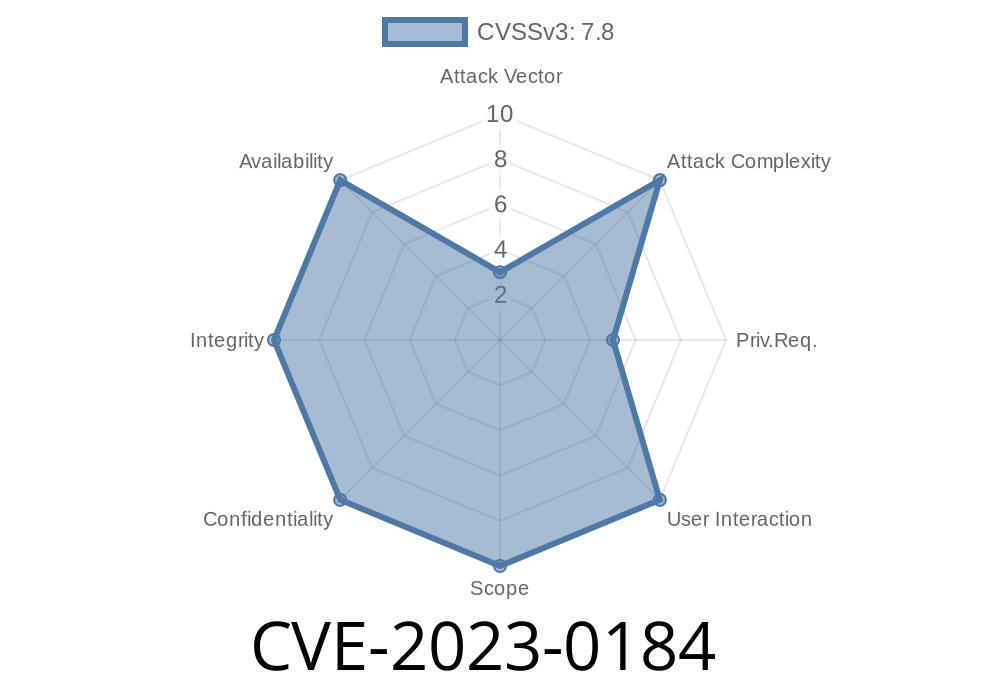When you hear “graphics driver,” you probably think about smooth gameplay or crisp video. But drivers run deep in your system, and bugs in them can become serious security risks. That’s exactly what happened with CVE-2023-0184, a critical vulnerability in the NVIDIA GPU Display Driver for both Windows and Linux. Let’s break down how it works, how attackers could use it, and what you need to do to stay protected.
What is CVE-2023-0184?
CVE-2023-0184 is a security flaw in the kernel mode layer handler of the NVIDIA GPU Display Driver. Specifically, a bug in how the driver validates (or rather, doesn’t validate) certain requests gives attackers ways to:
Crash your system (Denial of Service)
- Escalate privileges (go from normal user to system/root)
Tamper with your data
In other words: If you have a vulnerable NVIDIA driver and a mischievous program runs on your computer, it could take total control.
Who is Affected?
- Windows: All modern NVIDIA GeForce, Quadro, RTX, and other consumer/gaming GPUs.
- Linux: All desktop/workstation drivers for Linux distributions (Ubuntu, Fedora, etc.)
If you haven’t updated your NVIDIA drivers since early 2023, you may be vulnerable!
Official NVIDIA advisory:
https://nvidia.custhelp.com/app/answers/detail/a_id/5467
Vulnerability Details
The problem sits in the way the NVIDIA driver handles requests from user programs, specifically in the kernel layer handler. An attacker can craft a special request that:
Triggers the driver to access memory it shouldn’t
- Causes a buffer overflow or out-of-bounds read/write
Because the driver code runs in kernel mode (highest privileges), a vulnerable call can compromise your whole system.
Code Snippet (Simplified)
Attackers can exploit the vulnerable handler via system calls. Here’s a high-level (C-like pseudo-code) example of how this might look on Windows:
#include <windows.h>
#include <stdio.h>
#define NVIOCTL_CODE x0022C008 // Example ioctl code, not real!
int main() {
HANDLE hDevice = CreateFile(
L"\\\\.\\NvidiaDevice", // NVIDIA device interface
GENERIC_READ | GENERIC_WRITE,
, NULL, OPEN_EXISTING, , NULL);
if (hDevice == INVALID_HANDLE_VALUE) {
printf("Could not open device\n");
return 1;
}
char maliciousBuf[1024];
memset(maliciousBuf, 'A', sizeof(maliciousBuf));
DWORD returned;
// Exploit: send too-big buffer with crafted content
DeviceIoControl(
hDevice,
NVIOCTL_CODE,
maliciousBuf,
sizeof(maliciousBuf),
maliciousBuf,
sizeof(maliciousBuf),
&returned,
NULL
);
CloseHandle(hDevice);
printf("Done\n");
return ;
}
*Note*: The exact IOCTL code and buffer content differ depending on the vulnerable driver version, but researchers created proof-of-concepts along these lines.
Denial of Service: The system may BSoD (Windows) or panic (Linux).
- Privilege Escalation: Malicious code running as a normal user could overwrite important memory, then run code as System/root.
Information Disclosure: Sensitive kernel data (passwords, encryption keys, etc) could be leaked.
- Data Tampering: The driver could be tricked into writing attacker-controlled data to protected kernel memory.
Essentially, any malware running as a normal user can end up with total control over your computer. That’s about as bad as it gets.
How Was it Found?
Security researchers using fuzzers and reverse engineering tools found that certain NVIDIA kernel handlers didn’t check buffer sizes or pointer values properly. Some relevant research:
- Reverse Engineering NVIDIA Drivers: blog.z6c.io/post/nvidia-vulns/
- PoC for privilege escalation: github.com/RedDrip7/Nvidia_CVE-2023-0184 *(Note: for testing/education!)*
- Official NVIDIA fix: NVIDIA Security Bulletin: January 2023
Elevate privileges:
With kernel code execution, the exploit replaces its process token or injects into kernel memory, gaining system or root privilege.
Update your NVIDIA Driver NOW
- Go to https://www.nvidia.com/Download/index.aspx
Or use GeForce Experience / Linux package manager.
References
- NVIDIA Security Bulletin: January 2023
- Exploit PoC (for research)
- Reverse Engineering Blog on NVIDIA GPU exploits
- Common Vulnerabilities and Exposures – CVE-2023-0184
In Summary
CVE-2023-0184 is a dangerous NVIDIA GPU driver bug that could let any program take over your Windows or Linux PC. It’s already been exploited in lab tests, and could be a valuable tool for malware in the wild. Fixing it is as simple as updating your NVIDIA graphics driver — so don’t wait!
Timeline
Published on: 04/22/2023 03:15:00 UTC
Last modified on: 05/02/2023 14:24:00 UTC
